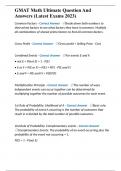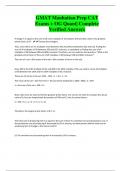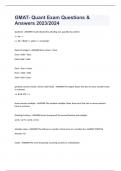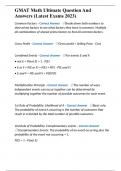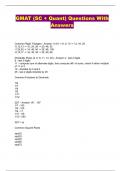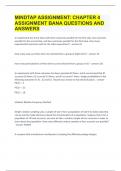Gmat exams - Study guides, Class notes & Summaries
Looking for the best study guides, study notes and summaries about Gmat exams? On this page you'll find 28 study documents about Gmat exams.
All 28 results
Sort by
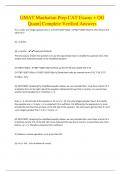
-
GMAT Manhattan Prep CAT Exams + OG Quant| Complete Verified Answers
- Exam (elaborations) • 65 pages • 2024
-
- $11.49
- + learn more
If x, y, and z are integers greater than 1, and (3^27)(35^10)(z) = (5^8)(7^10)(9^14)(x^y), then what is the value of x? (1) z is prime (2) x is prime - Exponents & Roots: The best way to answer this question is to use the exponential rules to simplify the question stem, then analyze each statement based on the simplified equation. (3^27)(35^10)(z) = (5^8)(7^10)(9^14)(x^y) Break up the 35^10 and simplify the 9^14 (3^27)(5^10)(7^10)(z) = (5^8)(7^10)(3^28)(x^y) Divide both sides by common te...
GMAT Math Ultimate Question And Answers (Latest Exams 2023)
GMAT Manhattan Prep CAT Exams + OG Quant| Complete Verified Answers
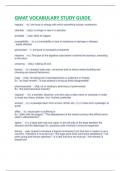
-
GMAT EXAMS PACKAGE DEAL GUIDE SOLUTION.
- Package deal • 14 items • 2023
-
- $20.49
- + learn more
GMAT EXAMS PACKAGE DEAL GUIDE SOLUTION.GMAT EXAMS PACKAGE DEAL GUIDE SOLUTION.GMAT EXAMS PACKAGE DEAL GUIDE SOLUTION.GMAT EXAMS PACKAGE DEAL GUIDE SOLUTION.GMAT EXAMS PACKAGE DEAL GUIDE SOLUTION.GMAT EXAMS PACKAGE DEAL GUIDE SOLUTION.GMAT EXAMS PACKAGE DEAL GUIDE SOLUTION.GMAT EXAMS PACKAGE DEAL GUIDE SOLUTION.GMAT EXAMS PACKAGE DEAL GUIDE SOLUTION
BUNDLE - GMAT EXAMS
GMAT Math Ultimate Question And Answers (Latest Exams 2023)
GMAT EXAM PACKAGED EXAMS WITH COMPLETE SOLUTIONS GRADED A+...
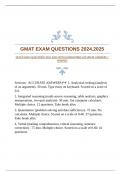
-
PACKAGE DEAL FOR GMAT EXAMS WITH GUARANTEED ACCURATE ANSWERS |COMPLETELY SOLVED!
- Package deal • 4 items • 2024
-
- $27.57
- + learn more
GMAT FOCUS PRACTICE EXAM SET WITH GUARANTEED ACCURATE ANSWERS GMAT PRACTICE QUESTIONS 2024.2025 WITH GUARANTEED ACCURATE ANSWERS |SOLVED!! GMAT PRACTICE QUESTIONS WITH GUARANTEED ACCURATE ANSWERS |VERIFIED GMAT EXAM QUESTIONS 2024.2025 WITH GUARANTEED ACCURATE ANSWERS |VERIFIED
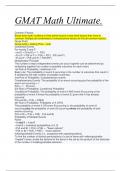
-
GMAT Exam Success Simplified: Comprehensive Guides for Testing Exams
- Exam (elaborations) • 24 pages • 2024
-
- $13.99
- + learn more
P(E) = 1 - P(not E) 3rd Rule of Probability: Conditional Probability Conditional Probability: The probability of event A AND event B occurring is the probability of event A times the probability of event B, given that A has already occurred. P(A and B) = P(A) × P(B|A) 4th Rule of Probability: Probability of A OR B The probability of event A OR event B occurring is: the probability of event A occurring plus the probability of event B occurring minus the probability of both events occurr...
GMAT BUNDLED EXAMS PACKAGE DEAL 2023/24|ALL GRADED A+|ALL FULLY SOLVED|DOWNLOAD TO PASS

How much did you already spend on Stuvia? Imagine there are plenty more of you out there paying for study notes, but this time YOU are the seller. Ka-ching! Discover all about earning on Stuvia

